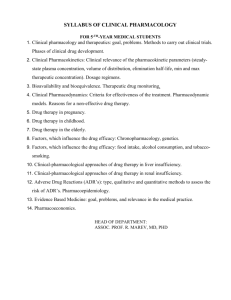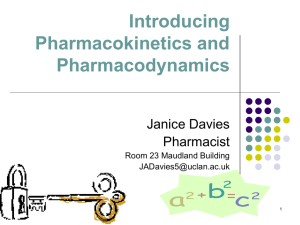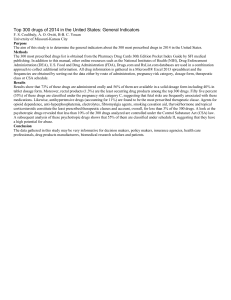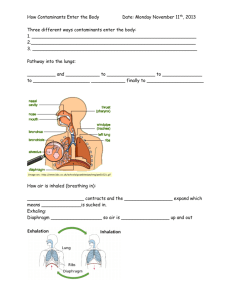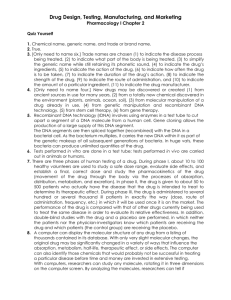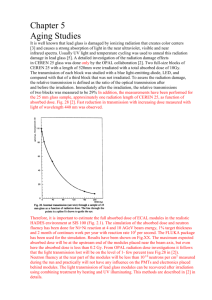Pharmacology Review
advertisement
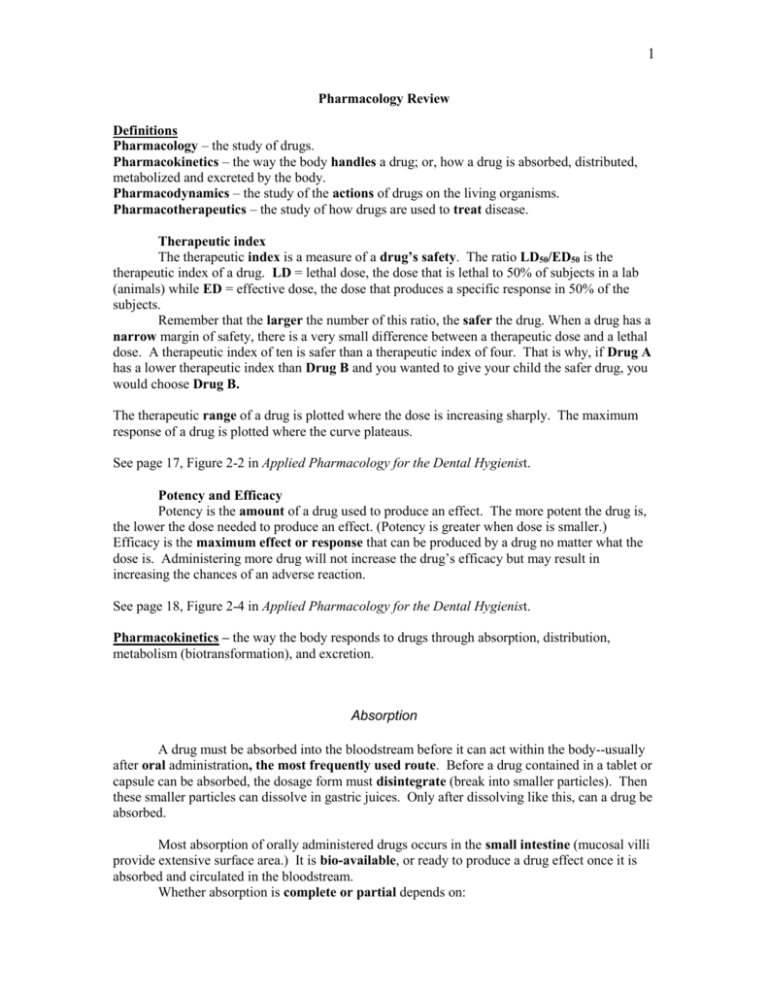
1 Pharmacology Review Definitions Pharmacology – the study of drugs. Pharmacokinetics – the way the body handles a drug; or, how a drug is absorbed, distributed, metabolized and excreted by the body. Pharmacodynamics – the study of the actions of drugs on the living organisms. Pharmacotherapeutics – the study of how drugs are used to treat disease. Therapeutic index The therapeutic index is a measure of a drug’s safety. The ratio LD50/ED50 is the therapeutic index of a drug. LD = lethal dose, the dose that is lethal to 50% of subjects in a lab (animals) while ED = effective dose, the dose that produces a specific response in 50% of the subjects. Remember that the larger the number of this ratio, the safer the drug. When a drug has a narrow margin of safety, there is a very small difference between a therapeutic dose and a lethal dose. A therapeutic index of ten is safer than a therapeutic index of four. That is why, if Drug A has a lower therapeutic index than Drug B and you wanted to give your child the safer drug, you would choose Drug B. The therapeutic range of a drug is plotted where the dose is increasing sharply. The maximum response of a drug is plotted where the curve plateaus. See page 17, Figure 2-2 in Applied Pharmacology for the Dental Hygienist. Potency and Efficacy Potency is the amount of a drug used to produce an effect. The more potent the drug is, the lower the dose needed to produce an effect. (Potency is greater when dose is smaller.) Efficacy is the maximum effect or response that can be produced by a drug no matter what the dose is. Administering more drug will not increase the drug’s efficacy but may result in increasing the chances of an adverse reaction. See page 18, Figure 2-4 in Applied Pharmacology for the Dental Hygienist. Pharmacokinetics – the way the body responds to drugs through absorption, distribution, metabolism (biotransformation), and excretion. Absorption A drug must be absorbed into the bloodstream before it can act within the body--usually after oral administration, the most frequently used route. Before a drug contained in a tablet or capsule can be absorbed, the dosage form must disintegrate (break into smaller particles). Then these smaller particles can dissolve in gastric juices. Only after dissolving like this, can a drug be absorbed. Most absorption of orally administered drugs occurs in the small intestine (mucosal villi provide extensive surface area.) It is bio-available, or ready to produce a drug effect once it is absorbed and circulated in the bloodstream. Whether absorption is complete or partial depends on: 2 drug’s physicochemical effects (relating to physical chemistry; that is, relating to the body vs. the mind) dosage form route of administration interactions with other substances in GI tract various patient characteristics These same factors also determine the speed of absorption. Oral solutions and elixirs, which bypass need for disintegration and dissolution, are usually absorbed more rapidly. Some tablets have enteric coatings that prevent disintegration in the acidic environment of the stomach; others may have coatings of varying thickness that delay release of the drug. Drugs administered intramuscularly must first be absorbed through the muscle into the bloodstream; rectal suppositories absorbed through rectal mucosa. Intravenous drugs go directly into the bloodstream and are completely and immediately bioavailable. IV drug administration is used in emergency situations. The rate and efficiency of absorption of a drug depends on the route of administration. Again, remember that absorption can occur at many sites in the body, mouth, stomach, muscles, etc. A dental example is tetracycline which is absorbed in sulcular tissues (mouth) when administered both locally and systemically. In what other body tissues is tetracycline absorbed? Ionization: absorption depends on the degree of ionization; the less ionized the drug more absorption; more ionized the drug less absorption. Lipid solubility: more lipid soluble the drug more readily absorbed; less lipid soluble less absorption lipid soluble drugs move across most biological membranes by diffusion lipid soluble drugs are the only drugs to pass the blood-brain barrier o blood-brain barrier - a collection of cells that press together to block many substances from entering the brain, while allowing others to pass o passage of drugs across the barrier is related to drug’s lipid solubility and degree of ionization o highly lipid soluble, non-ionized drugs easily cross the blood brain barrier Distribution Drugs are “transported” to site of action. Only the drugs that are free or unbound can cross cell membranes. An equilibrium occurs between the bound drug and the unbound (free) drug. Redistribution: The drug moves from one tissue (has an effect) to another tissue (is inactive). This is one way of ending a drug’s effect. Protein binding: drugs bind to protein receptors and once the drug binds to a protein receptor, it can no longer exert its pharmacologic effect. Drugs may compete for the same receptor site when more than one drug is present in the system. This results in the drug with the stronger affinity binding with the receptor site and the drug with the weaker affinity will exert its pharmacologic effect. 3 Example: warfarin (Coumadin) is 98% plasma protein bound, with only 2% of it free or unbound. If a drug interaction displaces only 2% of the bound warfarin, then 96% will be bound, but 4% will now be free. That is a 100% increase in the free concentration of warfarin, and it might double its pharmacological effect. Can you name a commonly used drug that may displace warfarin? By comparison, if a drug is only 50% bound, displacing 2% will cause only a minor increase in the free concentration. Protein-binding can be influenced by malnutrition, renal failure, and other protein-bound drugs. When protein-binding occurs, drug dosing may need to be modified. Tissue binding: some drugs can also bind to body tissues and exhibit chemical effects. Tetracycline impacts developing bones and teeth of the fetus and the young child. Do you recall which teeth are affected during fetal development and which teeth are affected in young children? You will most likely need to review your development and eruption patterns and dates from your Dental Anatomy course. Metabolism (Biotransformation) The liver is the major site for metabolism and hepatic microsomal enzymes are responsible for metabolism. Metabolites of drugs are formed so that they can be easily excreted. Metabolites are more polar, less lipid soluble and less protein bound so that they can be more easily excreted. Induction (stimulation) - drugs are capable of increasing the metabolizing enzymes in the liver. Induction increases the metabolism of drugs and usually results in a reduction in the pharmacological effect. Induction has a slower onset time than inhibition. Examples: barbiturates (i.e. phenobarbital), carbamazepine, phenytoin, rifampin, cigarette smoking and use of alcohol. All of these substances are known to “induce” metabolism. Inhibition - usually occurs when two drugs compete for binding sites on the liver’s metabolizing enzymes. This generally increases the plasma concentration (and thus, the pharmacologic effect) of at least one of the drugs. Enzyme inhibition is one of the most common drug interactions and has a rapid onset, usually within 24 hours. Disappears quickly once inhibitor is discontinued, is easier to predict because it appears to be dose-related. Drugs that share a similar chemical structure often share the potential for enzyme inhibition. Examples: cimetidine, erthyromycin Rates of metabolism vary with the individual. When drugs are quickly metabolized, the blood and tissue levels may prove therapeutically inadequate. When drugs are slowly metabolized, ordinary doses may produce toxic results. Excretion The kidneys are most common site (urine) of excretion. Excretion can also occur through feces, sweat, tears, lungs, saliva, and gingival crevicular fluid. Drugs may be excreted as metabolites or unchanged. Fat-soluble drugs are not excreted in urine; they must be metabolized into a water-soluble form by the liver. 4 o o o Other Modifying Factors in Pharmacokinetics Patient’s age Elderly Usually have decreased hepatic function, less muscle mass, and diminished renal function. Need lower doses and, sometimes, longer dosage intervals to avoid toxicity. Neonates Have underdeveloped metabolic enzyme systems and inadequate renal function. Need highly individualized dosages and careful monitoring. Underlying disease Acidosis - may cause insulin resistance Genetic diseases – certain genetic diseases (G6PD deficiency and hepatic porphyria) may turn drugs into toxins with serious consequences. Highly active hepatic enzyme systems (e.g. rapid acetylators such as people who are of Eskimo origin), when treated with isoniazid, (a tuberculosis drug) can develop hepatitis from the rapid intrahepatic buildup of a toxic metabolite. Things to Consider about Drug Administration 1. Dosage forms Oral solutions or elixirs of the same drug that may be in tablet or capsule form are more easily and completely absorbed (if tablet or capsule is too large to ingest because of illness) and produces higher blood levels than a tablet. e.g. digoxin - a potentially toxic drug; increased amount absorbed could cause toxicity. Sometimes a change in dosage form requires a change in dosage. 2. Routes of administration are not therapeutically interchangeable e.g. diazepam (anti-anxiety drug) - is readily absorbed orally but is slowly and erratically absorbed intramuscularly e.g. gentamicin (antibiotic) - must be given parenterally because oral administration yields inadequate blood levels to treat systemic infections 3. Improper storage Most drugs should be stored in tight containers protected from direct sunlight and extremes in temperature and humidity that can cause them to deteriorate. Some may require special storage conditions, such as refrigeration. 4. Timing of drug administration Sometimes, giving an oral drug during or shortly after mealtime decreases the amount of drug absorbed. This is not clinically significant with most drugs and may, in fact, be desirable with irritating drugs such as aspirin. But penicillins and tetracycline should not be scheduled for administration at mealtimes because certain foods can inactivate them. Do you know which foods do this? 5. Patient’s age, height, and weight Needed by doctor to calculate dosage for many drugs. 5 6. 7. Laboratory data also needed (i.e. renal and liver function studies) so dosage can be adjusted. Metabolic changes e.g. depressed respiratory function, acidosis or alkalosis (might alter drug effect) Patient’s history Obtain comprehensive history from patient or family. Do you remember how important this is? Ask about past drug reactions, possible genetic traits that might alter drug response, and current use of other drugs. Adverse Drug Reactions Toxic reactions are dose-related Side effects are dose-related. Drug allergies are not dose related; may be mild or could be life-threatening (anaphylaxis). o mild reaction – treat with antihistamine; may add steroids too o serious reaction – anaphylaxis; treated with epinephrine SC with or without steroids An exaggerated effect on target tissues – an extension of therapeutic effect caused by an overreaction of a sensitive patient or too large a dose of a drug. Idiosyncrasy – genetically based abnormal drug response. Autonomic Nervous System Parasympathetic Nervous System (PANS) Cholinergic/parasympathomimetic agents/drugs/agonists: o Acetylcholine is the neurotransmitter in the PANS. o Drugs used to treat xerostomia. i.e pilocarpine (Salagen) o See course notes for additional information. Anticholinergic agents/drugs/antagonists: o Block acetylcholine receptors by inhibiting effects of acetylcholine. o Avoid using these agents in patients who have narrow-angle glaucoma. o Drug used to dry saliva. i.e. atropine. o See notes for other additional information. Sympathetic Nervous System (SANS) Adrenergic/Sympathomimetic/agents/agonists o Norepinephrine is the neurotransmitter in the SANS. o Examples of drugs in this category: epinephrine, pseudoephedrine, albuterol (i.e. Proventil, Ventolin), methylphenidate (i.e. Ritalin, Adderall), diet pills (i.e. Dexedrine) Adrenergic/Sympathetic blocking agents/antagonists o Agents block effect of SANS o They inhibit the vasoconstricting (vessel narrowing) effects of adrenergic agents. 6 o Generic names of the beta-blocker drugs usually end in “olol” such as propranolol (Inderal), metoprolol (Lopressor), atenolol (Tenormin). Beta Receptors and Beta Blockers o Beta receptors are protein molecules located in: 1 - cells of heart 2 - cells of smooth muscle of blood vessels 2 - cells of smooth muscle of bronchi 1 - stimulated by epinephrine increased heart rate 2 - stimulation blood vessel constriction 2 - stimulation also bronchi to relax, increasing air flow to the lungs All of these are positive effects because the sympathetic nervous system raises blood pressure to take in more oxygen to prepare the body for “fight or flight”. However, these effects are NOT desirable in patients with hypertension or angina. That is why hypertensive patients are given drugs that block the action of epinephrine on beta receptors (beta blockers). Drugs that block both beta 1 and beta 2 receptors are called nonselective or nonspecific beta-blockers. Other drugs that are more selective and block only beta 1 receptors in the heart are called cardioselective or specific. Nonselective (nonspecific) beta-blockers would not be prescribed for hypertensive patients with asthma because they produce bronchial constriction, an undesirable condition in people with asthma. Rather, cardioselective (specific) beta-blockers would be prescribed. There are fewer side effects and drug interactions with cardioselective (specific) beta-blockers. References: Ballington and Laughlin, Pharmacology for Technicians, EMC Paradigm, 1999. Basic Pharmacology, Morton Publishing, First Edition, 2000. Requa-Clark, Applied Pharmacology for the Dental Hygienist, Mosby, Inc. Fourth Edition, 2000.

